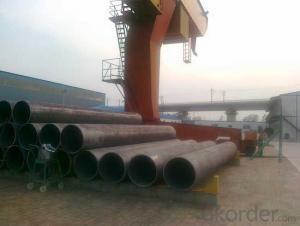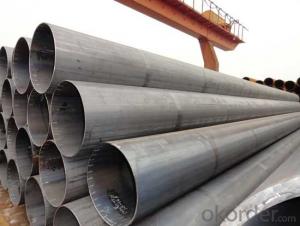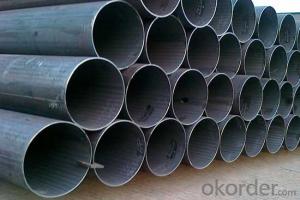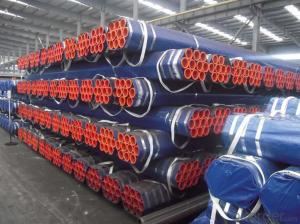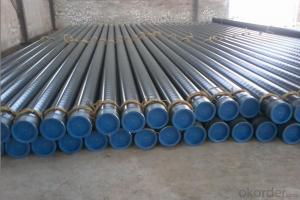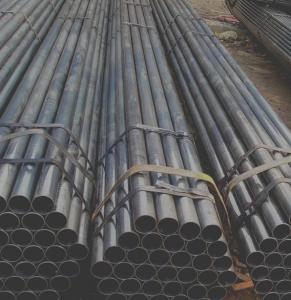LSAW Steel Pipe API Double Submerged Arc Welded Steel Pipe for Construction Structure
- Loading Port:
- Tianjin
- Payment Terms:
- TT or LC
- Min Order Qty:
- 5 m.t.
- Supply Capability:
- 10000 m.t./month
OKorder Service Pledge
OKorder Financial Service
You Might Also Like
LSAW Pipe
LSAW / Longitudinally Submerged Arc Welded Steel Pipe
Outer Diameter: 400-1520mm
Wall Thickness: 8mm ~ 50mm
Length: 3m ~ 12.3m
Standard / Steel Grade
API5LPSL1/PSL2Gr.B,X42~X80,ASTMA252Gr.2,Gr.3,ASTMA53Gr.B
EN10217-1,EN10219-1,EN10025 S235JR,S275JR,S355JR, EN10224 L235,L275,L355,DIN 1629 ST37,ST44,ST52
GB/T9711.1-1997,GB/T9711-2011: L245~L555
GB/T3091-2008:Q235B,Q345B,20#,16Mn etc.
Usage
For conveying petroleum, natural gas, coal gas,drainage,water, chemical material and other medium/low pressure liquids and used for piling project, electric power projects, heat-supply, shipbuilding & construction projects.
Delivery Condition
Beveled or plain ends with or without protector or protective caps with or without varnish/2PP/2PE/3PE/ 3PP/FBE external anti-corrosive coating with or without cement mortar/ /Liquid type epoxy resin/ FBE internal anti-corrosive coating as per customer's requirements
- Q:How do steel pipes handle thermal expansion?
- Steel pipes handle thermal expansion by expanding and contracting with changes in temperature. When the pipe is heated, it expands in length and diameter, and when it cools down, it contracts. To accommodate this expansion and contraction, steel pipes are usually installed with expansion joints or loops that allow them to flex and absorb the thermal expansion without causing damage or stress on the pipe or its connections. This helps to prevent leaks, buckling, or structural failures caused by the expansion and contraction of the steel pipe.
- Q:What are the different methods of pipe repair for steel pipes?
- When it comes to repairing steel pipes, there are several methods available that depend on the severity and location of the damage. Below, you will find a list of the most common methods used: 1. Welding: This method is frequently employed for fixing steel pipes, particularly when the damage is confined to a specific area. To execute this repair, the damaged portion of the pipe is removed and replaced with a new piece that is welded securely. Afterwards, the weld is thoroughly inspected to verify its strength and reliability. 2. Pipe wrapping: This approach entails wrapping a layer of fiberglass or epoxy tightly around the damaged section of the pipe. This wrap provides structural reinforcement and effectively prevents further leakage or corrosion. 3. Pipe lining: This technique involves inserting a flexible liner into the damaged pipe. The liner is typically composed of materials such as epoxy, PVC, or cured-in-place pipe (CIPP). Once inserted, the liner is either inflated or heated to conform to the shape of the pipe, creating a new inner surface that is resistant to corrosion and leakage. 4. Slip lining: Similar to pipe lining, slip lining involves placing a smaller diameter pipe inside the damaged one. The smaller pipe acts as a protective sleeve, reinforcing the structure and preventing further deterioration of the original pipe. 5. Pipe bursting: This method is utilized when the damage to the pipe is extensive. A new pipe is pulled through the damaged one using a hydraulic or pneumatic system. As the new pipe is pulled through, it bursts the old pipe, resulting in a larger diameter pipe with minimal disturbance to the surrounding area. 6. Clamp or sleeve repair: In cases where the damage is small and localized, a clamp or sleeve can be applied to temporarily or permanently fix the issue. The clamp or sleeve is placed securely over the damaged section to prevent leakage. It is important to keep in mind that the optimal method for repairing steel pipes depends on factors like the extent of damage, accessibility, cost, and structural requirements. It is recommended to consult with a professional pipe repair specialist or engineer to determine the most suitable method for your specific situation.
- Q:When can I use the PVC pipe and when to use the galvanized pipe?
- PVC pipeline use temperature is -5 to 90 degrees or so, according to the current market price of around 6000 yuan per ton, the price is cheap. Its corrosion resistance is good, can resist most of the acid and alkali, and unlike the steel pipe that is easy to rust, so in the construction of the upper and lower water pipes and other fields have gradually replaced the trend of steel pipe.
- Q:What are the different methods of heat treatment for steel pipes?
- Some of the different methods of heat treatment for steel pipes include annealing, quenching, tempering, normalizing, and stress relieving.
- Q:Can steel pipes be used for cooling systems?
- Yes, steel pipes can be used for cooling systems. Steel pipes are commonly used in various industrial cooling applications due to their durability, high strength, resistance to corrosion, and ability to withstand high pressure and temperature conditions.
- Q:What are the different pipe fittings used with steel pipes?
- Some different pipe fittings used with steel pipes include elbows, tees, reducers, couplings, and flanges.
- Q:Are steel pipes suitable for food processing facilities?
- Yes, steel pipes are suitable for food processing facilities. Steel pipes are widely used in the food processing industry due to their numerous benefits. Firstly, steel pipes are highly durable and can withstand high temperatures, pressures, and corrosive substances often used in food processing. This ensures the pipes will not degrade or contaminate the food products. Additionally, steel pipes are easy to clean and maintain, making them ideal for maintaining high levels of hygiene required in food processing facilities. Steel pipes also have excellent resistance to bacteria growth, further ensuring the safety and quality of the food being processed. Furthermore, steel pipes are cost-effective and have a long lifespan, making them a reliable and economical choice for food processing facilities. Overall, steel pipes are a suitable and preferred option for food processing facilities due to their durability, cleanliness, and resistance to contamination.
- Q:What are the common standards for coating and lining of steel pipes?
- The most common standards for coating and lining of steel pipes include the American Petroleum Institute (API) standards such as API 5L, API 5CT, and API 5LD. Other widely recognized standards include the American Water Works Association (AWWA) standards such as AWWA C210 and AWWA C213, as well as the National Association of Corrosion Engineers (NACE) standards such as NACE RP0188 and NACE RP0394. These standards ensure the proper selection, application, and performance of coatings and linings to protect steel pipes from corrosion and other external factors.
- Q:How do you calculate the pipe flow velocity coefficient for steel pipes?
- The pipe flow velocity coefficient for steel pipes can be calculated using the Manning's equation. Manning's equation is used to calculate the flow velocity in open channels and pipes, and it takes into account the hydraulic radius, slope, and roughness coefficient of the pipe. To calculate the pipe flow velocity coefficient for steel pipes, follow these steps: 1. Determine the hydraulic radius (R) of the steel pipe. The hydraulic radius is calculated by dividing the cross-sectional area of the pipe (A) by the wetted perimeter (P). The formula is R = A/P. 2. Find the slope (S) of the pipe. The slope represents the change in elevation divided by the length of the pipe. It is usually given as a ratio or a percentage. 3. Determine the roughness coefficient (n) of the steel pipe. The roughness coefficient represents the internal roughness of the pipe and can be obtained from literature or pipe manufacturer specifications. It is commonly given in terms of the Manning's roughness coefficient. 4. Substitute the values of hydraulic radius (R), slope (S), and roughness coefficient (n) into the Manning's equation: V = (1/n) * R^(2/3) * S^(1/2) where V is the flow velocity. 5. Solve the equation for V to calculate the pipe flow velocity coefficient for steel pipes. It is important to note that the calculated velocity coefficient may vary based on the specific pipe dimensions, flow conditions, and other factors. Therefore, it is recommended to consult relevant engineering standards or consult with a hydraulic engineer to ensure accurate and reliable calculations for specific applications.
- Q:What is ND steel pipe?
- ND steel 09CrCuSb steel is currently the most ideal "resistance to sulfuric acid dew point corrosion in steel (ND steel, ND steel, 09CrCuSb steel, 09CrCuSb steel), ND steel is widely used in the manufacture of economizer, served in the high sulfur content in flue gas of air preheater, evaporator and heat exchanger equipment for resist sulfur smoke gas dew point corrosion.
1. Manufacturer Overview |
|
|---|---|
| Location | |
| Year Established | |
| Annual Output Value | |
| Main Markets | |
| Company Certifications | |
2. Manufacturer Certificates |
|
|---|---|
| a) Certification Name | |
| Range | |
| Reference | |
| Validity Period | |
3. Manufacturer Capability |
|
|---|---|
| a)Trade Capacity | |
| Nearest Port | |
| Export Percentage | |
| No.of Employees in Trade Department | |
| Language Spoken: | |
| b)Factory Information | |
| Factory Size: | |
| No. of Production Lines | |
| Contract Manufacturing | |
| Product Price Range | |
Send your message to us
LSAW Steel Pipe API Double Submerged Arc Welded Steel Pipe for Construction Structure
- Loading Port:
- Tianjin
- Payment Terms:
- TT or LC
- Min Order Qty:
- 5 m.t.
- Supply Capability:
- 10000 m.t./month
OKorder Service Pledge
OKorder Financial Service
Similar products
New products
Hot products
Hot Searches
Related keywords
